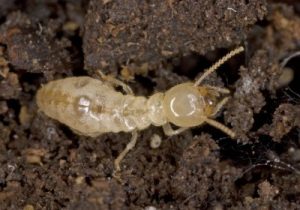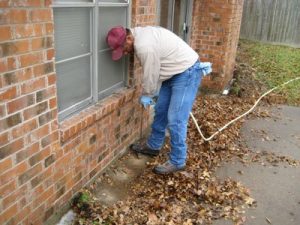
Subterranean termite is a real hidden pest.
The insect leads an extremely secret way of life, that is why sometimes it is very difficult to identify the presence of termites’ colony nest inside your house.
Hide content
- What Are the Mud Tunnels or Tubes?
- Where One Can Find Mud Tubes?
- How Does the Tube Look Like?
- What Types of Tunnels They Can Build?
- What Material Do They Use?
- What Does the Mud Tunnel Means?
- Useful articles
- Helpful video
- Conclusion
What Are the Mud Tunnels or Tubes?
Subterranean termite tubes or tunnels are special routes that are used by insects to maintain their life sustenance.
The tubes provide shelter for the foraging termites, they pass through this tunnel to work and find food and moisture for feeding.Subterranean termite tubes offer shelter that locks in moisture, and protects the termites from dry air and predators.
Where One Can Find Mud Tubes?
Subterranean termite tubes are most evident when they are extending over concrete foundations and other exposed surfaces.
One can find mud tubes in crawl and hidden places in a house, for example behind the plinths and basement window frames, as well as on the ceiling and concrete wall surface.
In order to find such signs of subterranean termite infestation, one should closely inspect the following exposed and hidden house structures as following:
- all wood constructions and materials in the basement and inside the hard-to-get-to spaces;
- all sills, sub floors, joists, support posts, supporting piers, basement window frames, wood under porches;
- take close notice on places where one can find concrete flooring: steps, porches, or slabs join the wooden structure;
- any scrap wood on the exterior of your house, old and rotten tree stumps, fence posts and basement windows exterior frames;
- cement expansion joints, cracks, and other areas that give termites an access to the structure of a house.
As it was mentioned above, subterranean termites can build their mud tunnel in hard-to-get-to veiled spaces, as well as on the solid structures as walls and the ceiling.
In principle, termites can occupy each free piece of space in order to get access to food and moisture. Subterranean termites can construct their tunnels on the following structures:
- On the foundation. Since subterranean termites base their nests under the ground surface, the basement walls are the first place on their way to your house and the easiest one to get in to. Subterranean termites will use each crack, joint or small hole in the foundation to enter the building.
- On the wall. A wall is the next step in termites’ journey to food and moisture. Usually, a mud tunnel on a wall means, that there is a huge “flour and basement” termite activity in your house.
- On the ceiling. Mud tunnels are so fest and solid, that they can keep on a ceiling. Mud tube on a ceiling can mean, that subterranean termite infestation slightly reaches its “scary” scale and the insects are trying to reach the second floor.
- In the garage. Garage is a perfect place for subterranean termites’ life sustenance. There are ideal conditions concerning humidity and temperature regime. Also, for termite a garage seems to be a fairly secret place.
Advice: if you find termite mud tunnels inside your house or garage, you should really call pest control professional. Termite infestation is very difficult to treat yourself but do a bit of diagnosis on your own.How Does the Tube Look Like?
Subterranean termites mud tubes are the most unmistakable sign of infestation.
Termite tubes are brown and look like pencil width sized tubes of mud spreading in irregular patterns from the soil upward toward the wooden portions of a building.
Recommendation: if you want to receive evidence, that you have found exactly a mud tube made by subterranean termites, you can remove the portion of a tunnel with a screwdriver and see if there are still termites inside.If you see an active movement inside with termites running back and forward it means, that you have a serious infestation. If the tunnel is empty, you can check it in a few days and see, whether the tube is repaired.
Even if it is not repaired it does not mean that the insects have abandoned your house for ever. It means probably that they have built a new tube somewhere nearby.
Learn more about subterranean termites: signs of their activity; best methods of treatment and DIY methods. Eastern subterranean termites.
Photo
Subterranean termite tubes pictures:
What Types of Tunnels They Can Build?
Subterranean termites build four types of tubes (tunnels).
- Working tubes are built from nests under the ground surface to wooden structures; the termites may travel up concrete surfaces or stone foundations.
- Exploratory and migratory tubes arise from the ground surface but do not connect to wood structures.
- Drop tubes extend from wooden structures back to the soil.
Attention! Mud tubes are a real proof of termite infestation inside the building, but their absence does not certainly mean that your house is free of termites. The termites may reach sills and other wood structures and materials through cracks or voids in the foundation, from earth-filled porches, steps, terraces.What Material Do They Use?
The tunnels may contain broken mud particles with fecal materials. Worker termites construct protective tunnels made of mud and saliva in order to reach above-ground wood.
When subterranean termites eat wood, they fill it with soil to help maintain the humidity. The tunnel walls are fest and solid, they are not so easy to remove, and when the newly built segment of a tunnel hardens, it becomes like a cement.
If a tube is old and abandoned, it is dry and easily destroys with a slight push.
What Does the Mud Tunnel Means?
The presence of mud tunnels (either active or abandoned) inside or outside the house is a sure sign of huge termites’ infestation.
Mud tubes means, that subterranean termites have settled down somewhere in the ground under the basement and have established a big nest.
The tube is a route to maintain the life of a present colony.
Be careful! Keep in mind, that just because you do not see any mud tunnel on the exterior of a building does not mean termites are not present. Termites often find paths to wooden structures via cracks or small holes in foundations, brick or exteriors, concrete stairs or patios.Here you can learn more information about effective treatment method called tenting (fumigation): dangers for termites, preparing for fumigation and cleaning after, how long does this procedure last?
Useful articles
If you interested in more information of termites we recommend you to read the following articles:
- All types of termites. Are they harmful to humans? Can they bite you? And what is the difference between drywood and subterranean ones?
- What does swarmers of different species look like: drywood, subterranean, formosan?
- Signs of infestation outside and in the house: in walls or furniture.
- What does termite holes look like? What is droppings and is it toxic to humans? Do termites make noises?
- Posible termite damage, how does it look like? Examples of damage in walls and wood floors.
- All about flying termites: how do they look like, swarming season and what to do if there are swarmers in your house?
- How do they do nests and mounds? How to find it in your garden or inside the house?
- Termite life cycle – from egg to larvae. And social hierarchy: workers, soldiers, queen.
Helpful video
Subterranean termites where tubing out of a concrete slab in the garage:
Conclusion
Though the presence of mud tubes inside your house is a serious sign of subterranean termites’ infestation, never try to remove these tunnels by your own and don’t believe, that such action can put an end to a problem.
It can even worsen the situation. Do not neglect periodical examination of crawl places in your house, but if you do find evidence of termites’ infestation, call a local pest specialist.
A special pest service members have tools, techniques and the experience to find termites even within the wood of walls, rafter, floors, and other places that would be nearly impossible for you to find.







